|
[ Back ] [ Home ] [ Up ]
[ Panama
City Recommendations ]
[ David &
Boquete Area Recommendations ]
|
Cursor over pictures to
display caption; click to enlarge then close out of that window.
|
|
PANAMA
Part 5:
(2009 - mid 2010)
| ♦
In and around Boquete area |
|
▫
Coffee |
|
▫
Indigenous Indians of Panama |
|
▫
Spanish ceremonial dress |
|
▫
Mondongo party |
| ♦ In and around David area |
|
▫
Medical stuff |
|
▫
Las Lajas, Pacific views |

|
| |
|
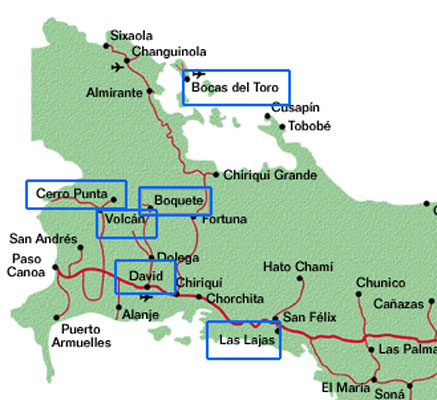
Destinations
referenced below (and our location in Bocas del Toro) boxed in
blue
|
|
|
|
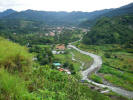
IN AND AROUND
BOQUETE AREA
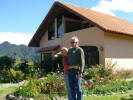 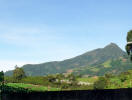 We've made several visits to the Boquete
(3,500 ft. elevation) area in the mountains, where good cruising friends &
Texans Mary Ellen and Randy have their home at 5,000 feet. They have a
spectacular close-up view of inactive volcano Barú, which is the highest
point in Panama at 11,400 feet. Their home is perched on a
plateau (enlarge picture at right, house is red roof at bottom right), surrounded by mountains and valleys. The Boquete area is
known for the bajareque, which is a heavy mist that moves through
typically in the afternoon, frequently accompanied by thick fog rolling
through below, at or above you. It brings a certain peace and
tranquility to the area, much as a light snow muffles far-off noises and makes those sounds close to you crisp. We've made several visits to the Boquete
(3,500 ft. elevation) area in the mountains, where good cruising friends &
Texans Mary Ellen and Randy have their home at 5,000 feet. They have a
spectacular close-up view of inactive volcano Barú, which is the highest
point in Panama at 11,400 feet. Their home is perched on a
plateau (enlarge picture at right, house is red roof at bottom right), surrounded by mountains and valleys. The Boquete area is
known for the bajareque, which is a heavy mist that moves through
typically in the afternoon, frequently accompanied by thick fog rolling
through below, at or above you. It brings a certain peace and
tranquility to the area, much as a light snow muffles far-off noises and makes those sounds close to you crisp.
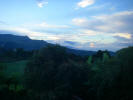 And during this season, And during this season,
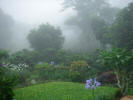 everything is very green and lush, as there is added rainfall, too.
Accordingly, you can go from t-shirt and shorts in the morning when the
skies are clear blue, to longer wear by afternoon or evening. You just
plan your day's activities around it. And as I write this long over
due website update, I'm sitting at their house (while they're in Texas
welcoming their first grandson!) getting inspiration (or is it
distractions!) from the magnificent views. everything is very green and lush, as there is added rainfall, too.
Accordingly, you can go from t-shirt and shorts in the morning when the
skies are clear blue, to longer wear by afternoon or evening. You just
plan your day's activities around it. And as I write this long over
due website update, I'm sitting at their house (while they're in Texas
welcoming their first grandson!) getting inspiration (or is it
distractions!) from the magnificent views.
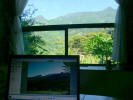
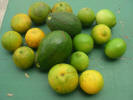 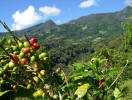
Their house sits in the middle of coffee
plants, and is surrounded by lots of orange, lime, grapefruit and avocado
trees that they planted.
|
| COFFEE
|
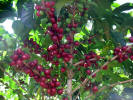 |
 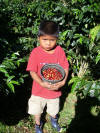 Mary
Ellen and Randy have an Indian, Omar, who tends to their
grounds. During the growing season, the coffee plant
starts off Mary
Ellen and Randy have an Indian, Omar, who tends to their
grounds. During the growing season, the coffee plant
starts off
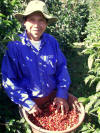 with
a delicate white flower, which turns into a green berry, then
ripens into a red "cherry". During the coffee picking
season (November - February) Omar recruits friends, big and
small, to selectively hand-pick only the ripe red "cherries",
leaving the green berries to ripen and be picked later.
This selective picking is more labor intensive and thus used for
the finer, high-end Arabica coffee found here in Panama.
The workers are paid by the quantity of cherries picked. with
a delicate white flower, which turns into a green berry, then
ripens into a red "cherry". During the coffee picking
season (November - February) Omar recruits friends, big and
small, to selectively hand-pick only the ripe red "cherries",
leaving the green berries to ripen and be picked later.
This selective picking is more labor intensive and thus used for
the finer, high-end Arabica coffee found here in Panama.
The workers are paid by the quantity of cherries picked.
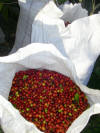 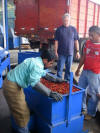 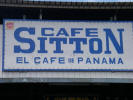 The
red cherries are bagged and must be taken to the coffee producer
within a day or two of picking. Mary Ellen and Randy have
chosen Cafe Sitton to sell to and process their coffee. We
went with them to drop off several big bags of picked coffee.
It's weighed, then dumped into a large "underground" water vat
for soaking, then many stages of processing. The
red cherries are bagged and must be taken to the coffee producer
within a day or two of picking. Mary Ellen and Randy have
chosen Cafe Sitton to sell to and process their coffee. We
went with them to drop off several big bags of picked coffee.
It's weighed, then dumped into a large "underground" water vat
for soaking, then many stages of processing.
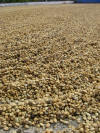
The outer
fruit or pulp of the cherry is removed at some point in the
processing, revealing the coffee bean (seed). Depending on
the method used, the cherries before "cleaning", or just the
beans, are dried on pavement in the sun. Yes, November -
February is considered part of the "dry" season here.
|
How's your Spanish?
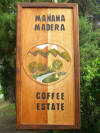
Mañana
Madera . . . "Morning Wood" |
|
MAÑANA
MADERA COFFEE ESTATE
Randy and Jamie
(neighbors of Randy & Mary Ellen) have about 6,000
coffee plants, and produce and sell their boutique
coffee themselves under the name
Mañana
Madera Coffee Estate.
Randy has come up with a blended coffee similar in
concept, for example, to a blended Cabernet Sauvignon-Merlot wine.
Their 2010 Special Reserve was rated "Excellent" when
officially tasted. Randy is currently (July 2010)
making daily shipments to the USA from Boquete, Panama.
Check out their website, better yet check out their
coffee and place your order before it's gone! We
certainly have been enjoying their specialty Panamanian
coffee! (Click on picture for link)
 |
|
|
|
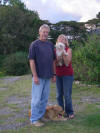 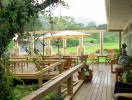 We've
had lots of good times in Boquete with Mary Ellen and Randy over the past
couple of years. They have shown us all around and we've met lots of
their friends. Now up here "on our own" we have met a lot of the local
gringos as we have joined in some of the activities such as hiking,
dinners and the weekly Tuesday Market (& meeting/program) - we can buy
wonderful home-made breads, soups, hydroponic greens and other produce,
hand-made wares, arts & crafts, etc. (There's always a spicy Thai soup
that I look forward to for breakfast, and Steve likes the potato & cheese
empanadas.) We stock up on bread (e.g., green olive & rosemary, jalapeño
& cheese), and fresh arugula
and basil (picture below - have you ever
seen such BIG leaves?!). We've
had lots of good times in Boquete with Mary Ellen and Randy over the past
couple of years. They have shown us all around and we've met lots of
their friends. Now up here "on our own" we have met a lot of the local
gringos as we have joined in some of the activities such as hiking,
dinners and the weekly Tuesday Market (& meeting/program) - we can buy
wonderful home-made breads, soups, hydroponic greens and other produce,
hand-made wares, arts & crafts, etc. (There's always a spicy Thai soup
that I look forward to for breakfast, and Steve likes the potato & cheese
empanadas.) We stock up on bread (e.g., green olive & rosemary, jalapeño
& cheese), and fresh arugula
and basil (picture below - have you ever
seen such BIG leaves?!).
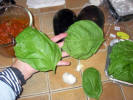
|
| INDIGENOUS INDIANS
of PANAMA
Panama has seven recognized indigenous Indian tribes that generally
live in their own comarca, similar to an Indian reservation
with it's protected area and own political system. They have their
own language distinct from Spanish. Some of these tribes have
blended in with the general population, while others have managed to
hold on to their traditions and their own language.
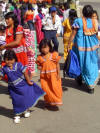 The
provinces of Chiriquí (includes Boquete and David) and Bocas del
Toro is home to the Ngöbé-Buglé
(formerly Guaymí) tribe,
which comprises roughly one-half of the indigenous
population of Panama. They speak Spanish but have attempted to
preserve their traditional way The
provinces of Chiriquí (includes Boquete and David) and Bocas del
Toro is home to the Ngöbé-Buglé
(formerly Guaymí) tribe,
which comprises roughly one-half of the indigenous
population of Panama. They speak Spanish but have attempted to
preserve their traditional way
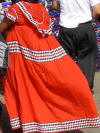 of life. Most notably is that
the women and girls wear their traditional dress, call la nagua :
colorful, loose-fitting, full-length dress (almost mumu style),
with a pinafore-type collar. The collars, sleeves, waist and
bottom are trimmed with what at first glance looks like rickrack,
but upon closer inspection is tedious, labor-intensive,
hand-embroidery. Others are made by hand-sewn appliqués, piecing
layers of different colored
fabrics together on top of the dress material (a bit reminiscent of
molas). The jagged edges and bright colors mimic the
surrounding mountains and forests. The men and boys wear
regular western dress. of life. Most notably is that
the women and girls wear their traditional dress, call la nagua :
colorful, loose-fitting, full-length dress (almost mumu style),
with a pinafore-type collar. The collars, sleeves, waist and
bottom are trimmed with what at first glance looks like rickrack,
but upon closer inspection is tedious, labor-intensive,
hand-embroidery. Others are made by hand-sewn appliqués, piecing
layers of different colored
fabrics together on top of the dress material (a bit reminiscent of
molas). The jagged edges and bright colors mimic the
surrounding mountains and forests. The men and boys wear
regular western dress.
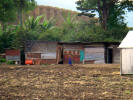
Yes, it is a common sight to see
these Indian women and girls wearing these dresses everyday whether
they're in town, walking down the road or working on a coffee or
other agricultural finca (plantation).
Probably the best known are the Kuna Indians who live in the Caribbean's San
Blas Islands, a matriarchal society where the women make and sell
molas. The other Indian tribes are: the Emberá
and Wounaan who live in the very wild Darién
jungle (borders Colombia), the Bokatá
(Bocas del Toro), the Bribri (Talamanca) (live near Costa
Rica border), and the Teribe (speak their own language).
|
|
| |
|
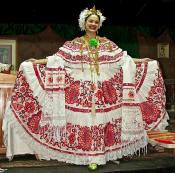 SPANISH
CEREMONIAL DRESS SPANISH
CEREMONIAL DRESS
I saw an
interesting and entertaining presentation on the pollera,
the traditional and ceremonial Spanish dress for Panamanian
women and girls, and currently the National Costume of Panama.
Typically, it takes about 1½
hours to be dressed; for this presentation it was crammed into
an hour. The
pollera consists of a couple layers of white petticoats with
ruffles and/or embroidery; an over-skirt with embroidery; a top
with layered
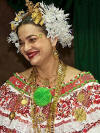 ruffles,
resting off the shoulders, decorated with embroidery and yarn
(and matching color pompom front and back); and slippers that
match the yarn color. Many gold chains (nine, I think if
you're wealthy) are placed around the neck, each with it's own
significance and design. The hair is parted perfectly down the
middle with 2 ponytails on either side at the back of the head.
The elaborate headdress is put into place individually (as
opposed to putting on one big "hat"). It consists of many
gold combs (mosquetas), and gold and pearl tembleques,
which are made up of beads attached to a spring so they tremble
and attract attention when the wearer moves or dances. ruffles,
resting off the shoulders, decorated with embroidery and yarn
(and matching color pompom front and back); and slippers that
match the yarn color. Many gold chains (nine, I think if
you're wealthy) are placed around the neck, each with it's own
significance and design. The hair is parted perfectly down the
middle with 2 ponytails on either side at the back of the head.
The elaborate headdress is put into place individually (as
opposed to putting on one big "hat"). It consists of many
gold combs (mosquetas), and gold and pearl tembleques,
which are made up of beads attached to a spring so they tremble
and attract attention when the wearer moves or dances.
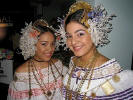 The
jewelry and head dressing are typically 10-carat gold for the
affluent, otherwise gold-plated silver. The polleras
are hand-made, and passed down as heirlooms through generations.
Families save money for years in order to be able to provide a
pollera for a daughter. Polleras reflect your
standing in society: Affluent women have a new one each
year; some may only have one as a girl and another when she
reaches adulthood (quinceañera)
at age 15. Polleras generally cost several thousand
dollars; the one shown above, based on the figures the presenter threw
out, I'd guess would cost all total close to $10,000 (but don't
quote me on that). The
jewelry and head dressing are typically 10-carat gold for the
affluent, otherwise gold-plated silver. The polleras
are hand-made, and passed down as heirlooms through generations.
Families save money for years in order to be able to provide a
pollera for a daughter. Polleras reflect your
standing in society: Affluent women have a new one each
year; some may only have one as a girl and another when she
reaches adulthood (quinceañera)
at age 15. Polleras generally cost several thousand
dollars; the one shown above, based on the figures the presenter threw
out, I'd guess would cost all total close to $10,000 (but don't
quote me on that).
(Big thanks
to Mark Heyer in Boquete for use of his photos, as I didn't have
my camera that day.)
|
|
|
|
| MONDONGO
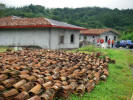 This
past weekend, we attended a mondongo, or mondongada
party, thrown by cruisers Dottie & Larry, m/v Changes in
Attitudes, who are building a house in Boquete (along with a
bunch of other cruisers we know). This
past weekend, we attended a mondongo, or mondongada
party, thrown by cruisers Dottie & Larry, m/v Changes in
Attitudes, who are building a house in Boquete (along with a
bunch of other cruisers we know).
The
Panama tradition is that when the roof goes on your house, you
raise a red flag and throw an appreciation party for the workers
thanking them for their hard labors. As the party was
originally for the workers, mondongo was typically
served. Mondongo (which I think translates to
"innards") is a
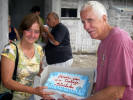 soup
delicacy made from tripe (cow's stomach, intestines) and is
similar to menudo in Mexico. As things evolved, the
party's invitee list was broadened to include the owner's family
and friends. soup
delicacy made from tripe (cow's stomach, intestines) and is
similar to menudo in Mexico. As things evolved, the
party's invitee list was broadened to include the owner's family
and friends.
Fortunately, Dottie & Larry think well of their friends and
instead of serving mondongo, served up hamburgers,
hotdogs and more along with copious amounts of beer and wine.
|
|
| |
|
IN AND AROUND
DAVID
AREA
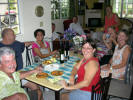 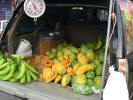 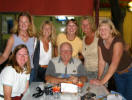 We've
been to David (2nd largest city in Panama, but it's still not that
big) several times: Routine medical exams, shopping, en route to Costa
Rica for immigration runs, en route to Boquete for visits, and a girls'
weekend get-away trip. We've
been to David (2nd largest city in Panama, but it's still not that
big) several times: Routine medical exams, shopping, en route to Costa
Rica for immigration runs, en route to Boquete for visits, and a girls'
weekend get-away trip.
|
|
MEDICAL COSTS
Here are some examples of typical medical costs
we paid in April 2010 in David, Panama:
$35
Office consult with doctor *
$100±
Routine blood/urine/stool lab **
$50
Shingles vaccination
$60
Ob/gyn exam, PAP, ultrasound *
$47
Mammogram **
$47
Bone Density **
* Doctors
freely spend as much time with you as you like,
and yes, our doctors speak English
** After
jubliado discount (for women 55 and
older, men 60 and older, varies 15-20%)
|
|
MEDICAL STUFF
We recently did our annual routine
physical exams in David, and as usual, are
very pleased with the medical attention we receive, the responsiveness of
the doctors, and how affordable it is
compared to the USA. The very efficient laboratory posts our lab
results online so they are readily available to us and our doctors. (See text boxes.)For medical
recommendations, see our
David &
Boquete Area Recommendations
write-up.
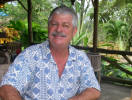
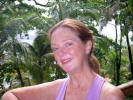
Looking and feeling healthy!
BELIEVE IT OR NOT
. . . and you won't . . .
One of the frustrating, but known things about
life down here is that even though somebody says
they will call you back, THEY NEVER DO.
But there is
one exception, and you won't believe this one.
Doctors, yes, DOCTORS answer their own cell
phones, take calls at their office, return calls
and reply to emails - all on a very timely
basis. Yep, they freely give out their
personal cell phone number and email address to
us.
|
|
|
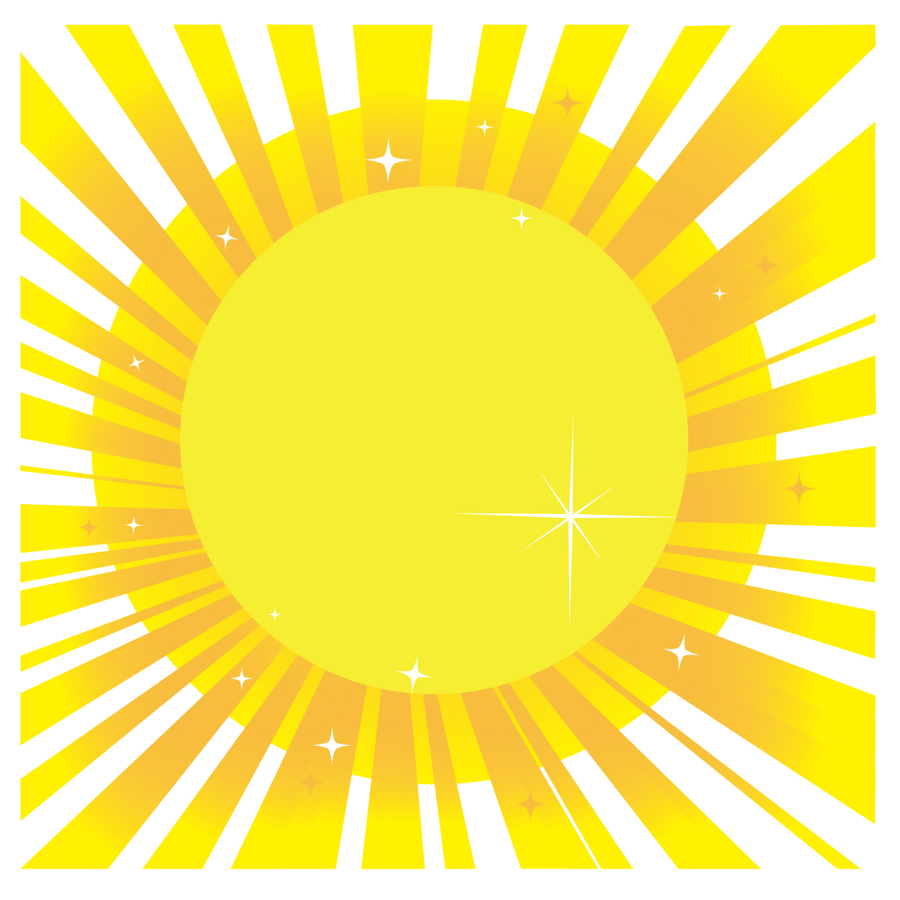 HOT FLASHES
. . . IN THE TROPICS! HOT FLASHES
. . . IN THE TROPICS!
I was worried about Steve when we left the states.
What was going to happen to him, alone in the middle of the ocean, with a
menopausal woman. Well, Steve, it hasn't been toooo bad now,
HAS IT ?!
But what has
been bad are hot flashes in the tropics. Oh man, it's bad enough in the air conditioning, but can you imagine it in the
hot, humid tropics? A doctor once advised me to dress in layers so I could
strip them off when a hot flash came on. Is he kidding or what!? I barely
wear clothes down here as it is!
Upon vacating my
seat after a sizzling round of dominoes, concurrent
with a major hot flash, a male friend sat down in my
chair and immediately jumps up exclaiming "WOW, this
seat is HOT!" . . . since I had
been playing poorly I knew he wasn't talking about
my gaming abilities . . .
|
|
|
|
|
|
|
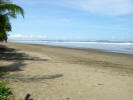 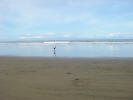 Las
Lajas lies on the Pacific
coast about 1½
hour drive from David. We decided to check out the Boca Chica area and
spend the night at the Las Lajas Beach Resort per recommendations from
friends. Clean, comfortable rooms with the extras, infinity pool,
open-air restaurant/bar and we were set. Lovely wide beach that
stretches for miles in either direction, with a backdrop of numerous islands,
and the mainland to the Las
Lajas lies on the Pacific
coast about 1½
hour drive from David. We decided to check out the Boca Chica area and
spend the night at the Las Lajas Beach Resort per recommendations from
friends. Clean, comfortable rooms with the extras, infinity pool,
open-air restaurant/bar and we were set. Lovely wide beach that
stretches for miles in either direction, with a backdrop of numerous islands,
and the mainland to the
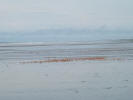 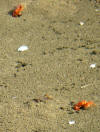 east.
You can practically walk a mile straight out and still stand up (the tide was out in
these pictures). Small, orangish-red crabs blanketed parts of the
beach, moving in unison as we approached. east.
You can practically walk a mile straight out and still stand up (the tide was out in
these pictures). Small, orangish-red crabs blanketed parts of the
beach, moving in unison as we approached.
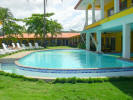 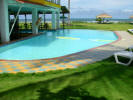
| |
|
|
|
|
Around David Area / Pacific Ocean Views |
| |
|
|
|
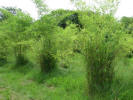 |
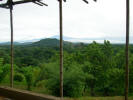 |
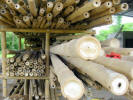 |
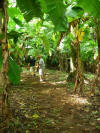 |
|
Bamboo farm: Takes about 5
years for bamboo to mature; these have a couple of more years to
grow; bamboo is treated in large pits |
Hiking an island |
| |
|
|
|
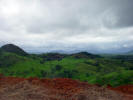 |
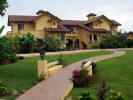 |
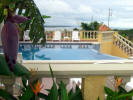 |
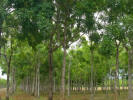 |
|
Boca Chica Plantation Club:
Great view, lovely clubhouse + infinity pool, mahogany (above right)
and teak tree groves |
| |
|
|
|
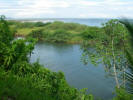 |
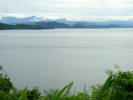 |
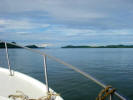 |
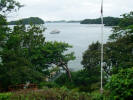 |
|
View of reefs, islands |
View of mainland from island |
View of mainland from water |
Gone Fishing marina & club in
Boca Chica |
| |
|
|
|
|
|
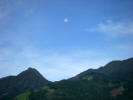 To be continued.
To be continued. |
[ Back ] [ Home ] [ Up ]
[ Panama
City Recommendations ]
[
David & Boquete Area Recommendations ]
[ Top of page ]
|
![]()